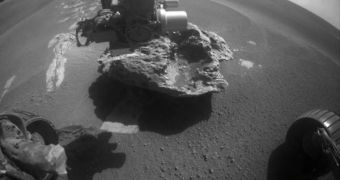While shifting through the data beamed back by the rover Opportunity from the surface of the Red Planet, scientists at the Jet Propulsion Laboratory (JPL), in Pasadena, California, discovered a dark, oddly shaped rock sitting right in the path of the rover. According to preliminary analysis reports, it may be that the formation is in fact a meteorite, although further analysis with Opportunity's onboard instruments is needed to confirm this. The rock measures about two feet (0.6 meters) across, and was discovered by the team on July 18th, Space reports.
Images showing the formation were recovered by the JPL scientists after the robot had already driven past the formation, and therefore it was given the command to stop and go back. Over the last weekend, the alpha particle X-ray spectrometer aboard the exploration robot was used to accurately determine the composition of the peculiar formation. Detailed results confirmed earlier suspicions that the fragment was, indeed, a meteorite. “It's pretty clear now that it is,” JPL scientist Albert Yen says.
The planetary expert has also revealed that Opportunity will remain in the area for a little longer, at least until the end of the week, in order to get a chance to better analyze the meteorite. Experts say that it could yield important data as to what the atmosphere and the soil of Mars may have looked like when it fell from the sky. Additionally, photographs revealed that tiny grains of sand still persisted in the rock's cracks, which means that it must have been buried under a superficial layer of dirt at some point.
Opportunity is currently heading towards a large crater on the surface of the planet, having already explored Victoria for about two years. It recently hit the ten-mile marker on Mars, but its instruments now show it went over more than 10.7 miles. In its five years of operations, this robot was the least damaged of the missions, experiencing only minor malfunctions. Conversely, its twin machine, Spirit, has been stuck in loose soil for quite some time now, and JPL experts are going out of their way to ensure that it is removed.

 14 DAY TRIAL //
14 DAY TRIAL //